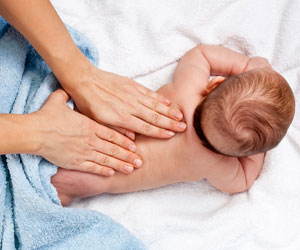Here’s the rub: Make massage part of bedtime
Before my first son was born, I’d always considered myself a baby person. I racked up babysitting gigs as a teenager and even volunteered in the infant room at the local daycare in college. Once Ben arrived, though, I was surprised to find that staying at home with a newborn wasn’t as rewarding as I thought it would be.
Then I discovered baby massage. It helped fill that difficult time in the late afternoon before my husband got home from work—just when Ben was starting to get fussy. But the biggest takeaway was the connection it helped me build with my new little boy.
How does it work?
Infant massage isn’t exactly like a spa rub-down—there’s no massage table required and it’s not going to put a dent in your bank account. All you need is your baby and a loving set of hands. Many parents start massaging their newborns without even knowing it: rubbing a soft belly on the changing table, caressing delicate fingers, patting underneath a dimpled bump.
But, if you can muster some extra energy in those first few weeks, learning a few formal strokes can make massage even more rewarding. Among the benefits of this focused touch for baby are relaxation, better sleep, and less crying, says Kelly Ross, M.D., a pediatrician at St. Louis Children’s Hospital, referencing a review of more than 20 studies of infant massage. Massage encourages mother-and-baby bonding and, instructors say, also improves digestion in infants.
In fact, there’s no downside to massaging your baby, says Ross, who massaged her triplets after they were born prematurely. Studies show that premature babies who are massaged have shorter hospital stays and gain more weight. Says Ross, “I’m all about trying things that don’t cause harm—and if they work for you, great.”
What to do
Baby massage definitely works for Jennifer Numainville a working mom from Oakland, CA. She and her husband, Mark, have been taking turns massaging their son Leo as part of his bedtime routine since he was a newborn. “By the time we get home, there’s only a short window before he’s ready for bed,” Numainville says. Both parents maximize this fleeting quality time through massage—it helps fathers or other caregivers bond with baby, too.
To get started, find a quiet, comfortable spot in a warm room and put down a blanket, playmat, or changing pad. “You’re setting up a predictable environment, so they know what’s going to happen,” says Mary Szegda, who teaches infant massage courses in Washington, D.C. Soothing music and dim lighting are also great cues, she says.
Have your baby naked or in just a diaper, or undress him as you go. Before you begin, Lesley Pearl, a massage therapist in Chicago, recommends gently resting your hands on your infant’s belly, making eye contact and telling him or her that you’re going to start massage. If your baby has splayed fingers, an arched back, or is turning away, these are likely signs that now’s not a good time, Pearl says.
Using a firm, slow, rhythmic touch, begin with the feet, Pearl suggests. You can massage without cream or oil, but some parents like to use it. Start with thumb-over-thumb stroking on each foot, squeeze the toes, and trace your baby’s anklebones with your fingers.
Then, move to the legs. Use one hand in a C-shape to draw down from the top of the leg to the foot while the other hand holds baby’s ankle, or do a comparable stroke up the leg to the hip. These motions can also be repeated on the arms.
The sun-moon is a popular stroke on the stomach. Begin by using the flat, padded surface of the fingers on your left hand to stroke clockwise around baby’s bellybutton. When the left hand reaches six o’clock, follow with the right, beginning at noon.
“Always keep one hand on the baby so nothing feels surprising,” Pearl says. And you shouldn’t feel pressure to massage from tiny toe to forehead to the point of meltdown. Your massage may only last five minutes and, for a newborn, that’s fine. Pearl often reminds parents, “It’s about making that connection and integrating that touch into your daily routine.” Before long, you’ll notice the benefits of touch for your baby—and you.
— Sarah J. Heim tries to fit in side-by-side massages each night for her sons, Benjamin, 2, and Reed, 5 months. When she’s not with her boys, she works as a college composition instructor and freelance writer.
